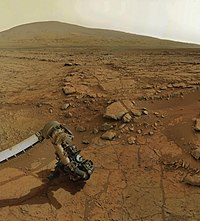
Back المنطقة المجرية الصالحة للحياة Arabic ছায়াপথীয় বাসযোগ্য ক্ষেত্র Bengali/Bangla Galactic habitable zone Danish ناحیه زیستپذیر کهکشانی Persian Galaktinen elämän vyöhyke Finnish Zone habitable galactique French Galaktikus lakható övezet Hungarian Zona galattica abitabile Italian 은하 거주가능 영역 Korean Zona habitável galáctica Portuguese
 |
| This article is one of a series on: |
| Life in the universe |
|---|
| Outline |
| Planetary habitability in the Solar System |
| Life outside the Solar System |
| Habitability of... |
In astrobiology and planetary astrophysics, the galactic habitable zone is the region of a galaxy in which life might most likely develop. The concept of a galactic habitable zone analyzes various factors, such as metallicity (the presence of elements heavier than hydrogen and helium) and the rate and density of major catastrophes such as supernovae, and uses these to calculate which regions of a galaxy are more likely to form terrestrial planets, initially develop simple life, and provide a suitable environment for this life to evolve and advance.[1] According to research published in August 2015, very large galaxies may favor the birth and development of habitable planets more than smaller galaxies such as the Milky Way.[2] In the case of the Milky Way, its galactic habitable zone is commonly believed to be an annulus with an outer radius of about 10 kiloparsecs (33,000 ly) and an inner radius close to the Galactic Center (with both radii lacking hard boundaries).[1][3]
Galactic habitable-zone theory has been criticized due to an inability to accurately quantify the factors making a region of a galaxy favorable for the emergence of life.[3] In addition, computer simulations suggest that stars may change their orbits around the galactic center significantly, therefore challenging at least part of the view that some galactic areas are necessarily more life-supporting than others.[4][5][6]
- ^ a b Gowanlock, M. G.; Patton, D. R.; McConnell, S. M. (2011). "A Model of Habitability Within the Milky Way Galaxy". Astrobiology. 11 (9): 855–73. arXiv:1107.1286. Bibcode:2011AsBio..11..855G. doi:10.1089/ast.2010.0555. PMID 22059554. S2CID 851972.
- ^ Choi, Charles Q. (21 August 2015). "Giant Galaxies May Be Better Cradles for Habitable Planets". Space.com. Retrieved 24 August 2015.
- ^ a b Prantzos, Nikos (2006). "On the "Galactic Habitable Zone"". Space Science Reviews. 135 (1–4): 313–22. arXiv:astro-ph/0612316. Bibcode:2008SSRv..135..313P. doi:10.1007/s11214-007-9236-9. S2CID 119441813.
- ^ Rok Roškar; Debattista; Quinn; Stinson; James Wadsley (2008). "Riding the Spiral Waves: Implications of Stellar Migration for the Properties of Galactic Disks". The Astrophysical Journal. 684 (2): L79. arXiv:0808.0206. Bibcode:2008ApJ...684L..79R. doi:10.1086/592231. S2CID 15219277.
- ^ University of Washington (15 September 2008). "Immigrant Sun: Our Star Could Be Far from Where It Started in Milky Way". Newswise. Retrieved September 15, 2008.
- ^ Battersby, Stephen (November 30, 2011). "Earth's wild ride: Our voyage through the Milky Way". New Scientist (2841).
© MMXXIII Rich X Search. We shall prevail. All rights reserved. Rich X Search